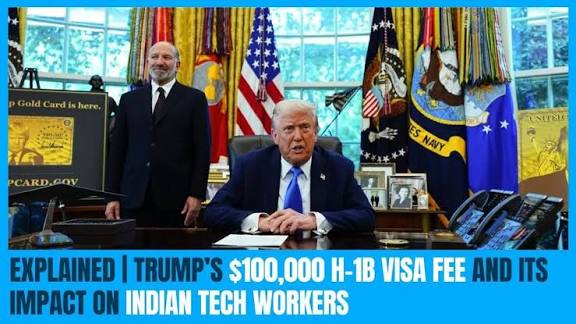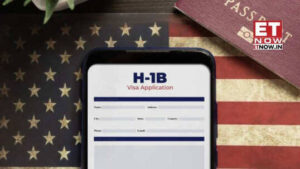$100,000 H-1B Fee: What It Means for Tech Workers & Indian Professionals

The Trump administration increases the fee by $ 100,000 for H -1B visas, which is likely to rank technical officials seeking qualified workers from abroad. Today we will discuss about $100,000 H-1B Fee: What It Means for Tech Workers & Indian Professionals
$100,000 H-1B Fee: What It Means for Tech Workers & Indian Professionals
In September 2025, the U.S. government introduced a sweeping change to its H-1B visa policy: a staggering $100,000 fee associated with H-1B applications for new applicants. For many tech workers—especially from India—this has triggered alarm, confusion, and urgent recalculations of career, financial, and migration plans. What does this change mean practically? Who gets affected? And how are Indian professionals likely to respond or adapt?
What Exactly Changed

Here’s a breakdown of what is known (as of mid-September 2025):
-
The new fee is $100,000 per H-1B visa application for new applicants.
-
It does not apply to existing H-1B visa holders nor to renewals of H-1B visas obtained before September 21, 2025.
-
It appears to be a one-time fee for new visas rather than an annual cost, though early reports suggested potential annual renewal fees. Official clarifications emphasized one-time charge for new petitions.
-
The policy went into effect (for new applications) from about September 21, 2025.
Why This Was Introduced
Understanding the reasoning helps see where this may lead. The official justifications include:
-
Prioritizing American workers: U.S. officials argue that higher costs for employing foreign tech workers (via H-1B) could encourage employers to hire Americans more aggressively.
-
Immigration policy overhaul: This move is part of a broader push on legal immigration reform, especially concerning skilled worker visas.
-
Economic / Fiscal: Perhaps to raise revenue, shift burdens of foreign labor, or reduce dependency on foreign skilled workforce. While not stated overtly in all reports, these are typical motivations in such policies.
Immediate Impact: Panic, Confusion & Clarifications
As soon as the policy was announced:
-
Widespread panic among tech workers, students, professionals, and companies relying on H-1B talent. Many interpreted the fee as applying also to renewals, or that it might be annual.
-
Clarifications from the White House: Existing visa holders and renewals are exempt; only new H-1B petitions filed on or after the effective date are subject.
-
International response (especially India) critical: concerns about economic, human, and talent mobility consequences.
Who Is Most Affected
The change doesn’t impact everyone equally. Some of the ones most affected include:
| Category | Likely Impact |
|---|---|
| New H-1B Applicants (esp. tech roles) | Will face the full $100,000 cost; this might deter many from applying. |
| Indian Professionals & Students | Since Indians constitute a large share of H-1B visa holders, many potential applicants will be affected. Costs, planning, and decisions will shift. |
| Tech Companies / Employers | Will need to allocate much larger budget per foreign hire. Smaller firms may find this cost prohibitive. |
| Startups | Especially vulnerable: foreign talent is often key, and budgets are tight. A $100,000 cost per new employee could significantly alter hiring patterns. |
| Offshore / Outsourcing Firms | Indian IT companies that send personnel to the U.S. on H-1B may see disruption; offshore delivery models may get more attractive. |
Implications for Indian Professionals & Tech Workers
For Indian professionals, whether aspiring or already abroad, this new rule shifts both the opportunities and the risks. Below are key implications:
1. Financial Burden
-
The $100,000 cost is huge compared to existing visa fees (which were much smaller, often in the thousands).
-
This cost may need to be borne by employers, employees, or shared. In many past H-1B arrangements, employers pay a sizeable portion, but with this scale, there will likely be pushback or renegotiations.
-
For individuals, this could mean higher demands for salary, or reduced job offers for foreign hires.
2. Career Planning
-
Students considering studying in the U.S. with intention of staying via H-1B may rethink that path.
-
Professionals already in India may weigh options more carefully: whether to try for U.S., consider other countries (Canada, Australia, Europe), or build careers in India.
-
Indian diaspora already in the U.S. may still be safe if they renew or stay, but migration intentions (re-entry, moving family) could get complicated.
3. Company Strategy / Employer Behavior
-
Employers may reduce dependency on H-1B visas, preferring to hire locally, upskill U.S. graduates, or use remote/contract labor.
-
Some may shift more of their operations to India or other countries (“offshoring”) to avoid high costs. Indeed, experts are already forecasting such shifts.
-
Companies might also push for automated / AI solutions to reduce human labor needs in certain roles, if cost becomes prohibitive.
4. Brain Drain vs Brain Retention in India
-
Paradoxically, while this may reduce outflow of talent, it might also spur development back home: Indian professionals may invest in Indian startups, R&D, local tech sectors.
-
Government and industry in India might use this moment to build domestic opportunities, improve compensation, and retain talent. India’s Commerce Minister has already called this “an urge” for NRIs to bring innovation back.
5. Uncertainty & Legal / Policy Risks
-
Any such sweeping change is likely to be challenged legally. Some observers are questioning whether the executive branch has legal authority to impose this fee without Congressional approval.
-
Implementation logistics: how the fee will be collected, how exemptions will work, timelines, policy interpretations—all these generate uncertainty.
-
Travel and re-entry issues: While existing holders are exempt, clarifying that reentry, renewals, etc., are unaffected helps, but confusion persists.
Broader Effects on Tech, Innovation & U.S.-India Relations
Beyond individual careers, the policy is likely to ripple through multiple systems:
-
Impact on U.S. Tech Industry: A $100,000 fee makes hiring foreign skilled workers much costlier. Some companies may avoid H-1B altogether, potentially losing access to global talent. This could slow innovation, especially in smaller firms or startups that cannot absorb such costs.
-
Global Talent Competition: Other countries may become more attractive destinations. Skilled workers may prefer places with easier immigration paths.
-
India’s IT ecosystem: Could benefit via increased outsourcing/offshoring, growth of remote work, or “reverse migration” of tech talent returning home. But this requires improved infrastructure, compensation, and opportunities.
-
Diplomatic & Economic Relations: India has already voiced concerns about “humanitarian consequences” and taken note of how this affects bilateral cooperation.
Strategies & Possible Responses for Indian Tech Workers
Given these changes, here are what Indian tech professionals (and those considering the H-1B path) may think about doing:
-
Explore Alternative Immigration Destinations
Countries like Canada, Australia, UK, EU are often perceived as having more stable/transparent skilled-worker paths. Canadian express entry, for instance, or global visas might look more attractive. -
Negotiate with Employers
If being offered H-1B sponsorship, negotiate who bears the fee, whether partial reimbursement is possible, or adjust salary offers accordingly to reflect higher costs. -
Develop Remote / Global Work Opportunities
Remote roles for U.S./global companies without requiring visa relocation might become more appealing. Building skills that are globally in demand can enable remote contracting or freelancing. -
Skill Up & Specialize in Fields with High Demand
Areas like AI/ML, cybersecurity, data science, cloud computing are often in shorter supply domestically and globally. Being in a niche might give better bargaining power, possibly exemptions or consideration under “national interest” clauses (if such apply). -
Keep Close Watch on Legal & Policy Updates
Rules may change, get clarified, or face court challenges. Staying informed is crucial (via immigration lawyers, official U.S. government sources, Indian government advisories). -
Consider Building Career in India / Other Regions
For many, the calculus may shift such that staying in India or working for global firms from India becomes more financially and personally viable. Investing locally may yield better returns in some cases.
Challenges & Criticisms of the Policy
Critics have raised several concerns and potential issues:
-
Access & Equity: A large fee could exclude talented individuals from less affluent backgrounds, causing loss of diversity.
-
Impact on existing ecosystems: Universities, research labs, startups that have historically relied on international students and professionals may struggle.
-
Implementation fairness: Clarification is needed about how “new” is defined, whether startup-class companies paying less can be exempt, or what counts as “national interest.”
-
Legal challenges: Whether this kind of fee can be imposed by executive proclamation is under question; Congress traditionally holds power over immigration law.
-
Wider economic consequences: If U.S. firms cannot attract foreign talent, innovation, competitiveness, and global standing could suffer.
FAQs / Key Questions
| Question | Answer |
|---|---|
| Does this affect current H-1B visa holders? | No—renewals and status of existing holders (before Sept 21, 2025) are exempt. |
| Is the $100,000 fee annual or one-time? | It appears to be one-time for new applications; early reports of annual fees were clarified down. |
| When does it take effect? | For new H-1B visa applications filed on or after about September 21, 2025. |
| Will Indian professionals still be able to apply? | Yes—but under much higher cost. Whether employers will continue sponsoring at same levels is uncertain. |
Potential Long-Term Outcomes
-
Reduced H-1B Petitions: With costly fees, many employers may reduce or cease filing H-1B petitions unless absolutely necessary.
-
Increase in Offshoring: More work may be done remotely from India or neighboring countries instead of relocating personnel to the U.S.
-
Large Scale Talent Retention in India: Return migration, or staying in India, could bring both challenges and opportunities: pressure on domestic job market, but also economic growth, innovation, startup culture.
-
Policy Evolution: Possible legal challenges, amendments, or maybe creation of exceptions (e.g. for startups, for “national interest” roles).
Conclusion
The $100,000 H-1B fee is one of the most dramatic shifts in U.S. immigration policy in recent memory—especially for tech workers and Indian professionals. Beyond the financial burden, it forces a recalibration of migration decisions, employer strategies, talent flows, and global career paths. Whether it ends up being a deterrent, catalyst for change, or something in between, depends heavily on:
-
How it’s implemented, regulated, and potentially challenged.
-
How Indian professionals, tech companies, and governments respond.
-
What alternative pathways emerge that could offset the disadvantages of this fee.
Ultimately, this policy shift underscores a growing tension in many countries: balancing protection of domestic labor markets with continuing to attract global talent, innovation, and international cooperation.
How useful was this post?
Click on a star to rate it!
Average rating 0 / 5. Vote count: 0
No votes so far! Be the first to rate this post.
About the Author
usa5911.com
Administrator
Hi, I’m Gurdeep Singh, a professional content writer from India with over 3 years of experience in the field. I specialize in covering U.S. politics, delivering timely and engaging content tailored specifically for an American audience. Along with my dedicated team, we track and report on all the latest political trends, news, and in-depth analysis shaping the United States today. Our goal is to provide clear, factual, and compelling content that keeps readers informed and engaged with the ever-changing political landscape.




